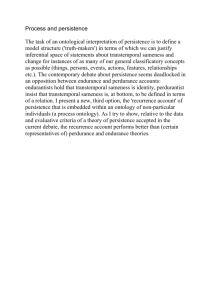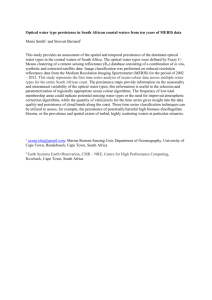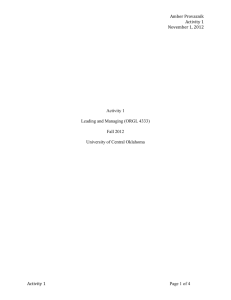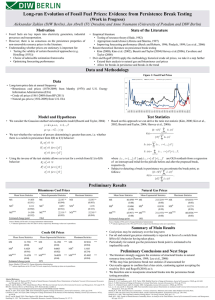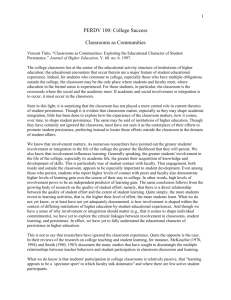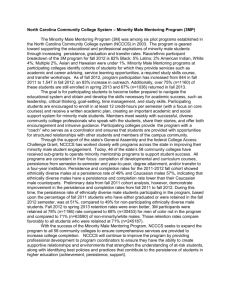to get the file
advertisement
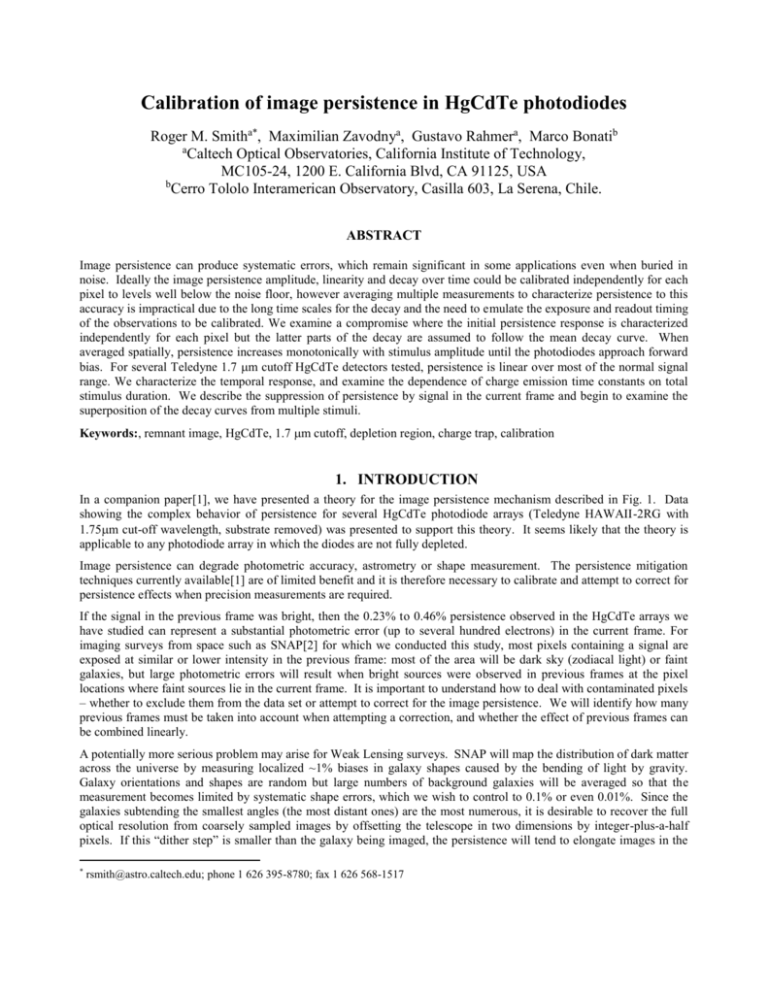
Calibration of image persistence in HgCdTe photodiodes Roger M. Smitha*, Maximilian Zavodnya, Gustavo Rahmera, Marco Bonatib a Caltech Optical Observatories, California Institute of Technology, MC105-24, 1200 E. California Blvd, CA 91125, USA b Cerro Tololo Interamerican Observatory, Casilla 603, La Serena, Chile. ABSTRACT Image persistence can produce systematic errors, which remain significant in some applications even when buried in noise. Ideally the image persistence amplitude, linearity and decay over time could be calibrated independently for each pixel to levels well below the noise floor, however averaging multiple measurements to characterize persistence to this accuracy is impractical due to the long time scales for the decay and the need to emulate the exposure and readout timing of the observations to be calibrated. We examine a compromise where the initial persistence response is characterized independently for each pixel but the latter parts of the decay are assumed to follow the mean decay curve. When averaged spatially, persistence increases monotonically with stimulus amplitude until the photodiodes approach forward bias. For several Teledyne 1.7 m cutoff HgCdTe detectors tested, persistence is linear over most of the normal signal range. We characterize the temporal response, and examine the dependence of charge emission time constants on total stimulus duration. We describe the suppression of persistence by signal in the current frame and begin to examine the superposition of the decay curves from multiple stimuli. Keywords:, remnant image, HgCdTe, 1.7 m cutoff, depletion region, charge trap, calibration 1. INTRODUCTION In a companion paper[1], we have presented a theory for the image persistence mechanism described in Fig. 1. Data showing the complex behavior of persistence for several HgCdTe photodiode arrays (Teledyne HAWAII-2RG with 1.75m cut-off wavelength, substrate removed) was presented to support this theory. It seems likely that the theory is applicable to any photodiode array in which the diodes are not fully depleted. Image persistence can degrade photometric accuracy, astrometry or shape measurement. The persistence mitigation techniques currently available[1] are of limited benefit and it is therefore necessary to calibrate and attempt to correct for persistence effects when precision measurements are required. If the signal in the previous frame was bright, then the 0.23% to 0.46% persistence observed in the HgCdTe arrays we have studied can represent a substantial photometric error (up to several hundred electrons) in the current frame. For imaging surveys from space such as SNAP[2] for which we conducted this study, most pixels containing a signal are exposed at similar or lower intensity in the previous frame: most of the area will be dark sky (zodiacal light) or faint galaxies, but large photometric errors will result when bright sources were observed in previous frames at the pixel locations where faint sources lie in the current frame. It is important to understand how to deal with contaminated pixels – whether to exclude them from the data set or attempt to correct for the image persistence. We will identify how many previous frames must be taken into account when attempting a correction, and whether the effect of previous frames can be combined linearly. A potentially more serious problem may arise for Weak Lensing surveys. SNAP will map the distribution of dark matter across the universe by measuring localized ~1% biases in galaxy shapes caused by the bending of light by gravity. Galaxy orientations and shapes are random but large numbers of background galaxies will be averaged so that the measurement becomes limited by systematic shape errors, which we wish to control to 0.1% or even 0.01%. Since the galaxies subtending the smallest angles (the most distant ones) are the most numerous, it is desirable to recover the full optical resolution from coarsely sampled images by offsetting the telescope in two dimensions by integer-plus-a-half pixels. If this “dither step” is smaller than the galaxy being imaged, the persistence will tend to elongate images in the * rsmith@astro.caltech.edu; phone 1 626 395-8780; fax 1 626 568-1517 direction of the dither. To first order this is calibrated by the deconvolution of the PSF measured by stars, but any differences in image persistence behavior for the stars used to measure the PSF and the galaxies to be deconvolved will introduce a systematic shape error. To calibrate for persistence we must understand the rate at which persistence decays, the spatial variation in its amplitude, whether the shape of the decay curve varies from pixel to pixel, linearity versus stimulus amplitude, how to combine the effect of persistence from multiple previous frames and how the persistence behavior is modulated by signal in the current frame. In a companion paper[1] we have described a persistence mechanism (Fig. 1) wherein traps near the edge of the depletion region are exposed to charge as the depletion width shrinks in response to accumulation of photo-generated charge and dark current while the diode is electrically isolated. Over the course of the exposure an increasing number of traps capture charge which remains behind when edge of the depletion region recedes at the time the diode is reset. The trapped charge is released gradually during the next and subsequent exposures, at which time the electric field across the depletion region sweeps emitted charge towards the outer edges of the depletion region. The motion of de-trapped charge induces a voltage change, which is interpreted as a signal. Fig. 1: Persistence model: as photo-generated charge accumulates, the depletion region shrinks exposing traps at the edge of the depletion region to carriers. Trapped charge begins to be released once the depletion edge recedes (when the diode is reset) and typically continues to be released for up to ten times the exposure duration. 2. TRAP EMISSION TIME CONSTANTS Continuous nondestructive readout allows the trap emission time constants to be measured. Several 600s dark exposures were sampled-up-the-ramp (non-destructively) after a long period without illumination. The average curve from these dark exposures captured both dark current and self-heating effects (once called “reset anomaly”). This curve was then subtracted from a similar sequence taken immediately after a bright-but-unsaturated 300s exposure to reveal the component of the dark signal due to charge emission by traps. A least-squares fit of a double exponential with unconstrained offset provided a good fit with Y intercept within 4% of full scale from the origin, the correct value. By contrast, a least squares fit to single exponential plus constant clearly fits poorly (Fig. 2) yielding a significantly nonzero Y intercept (25% of final value). Fort the double exponential, the two time constants differed by an order of magnitude suggesting that there may be two trap populations. It would not be unreasonable for electrons and holes to behave differently. The two time constant response suggests a mitigation scheme in which a delay is inserted between exposures to allow the fast traps to emit their charge prior to the baseline being established for the next exposure. It doesn’t matter whether resets occur during this delay. For example, a 28 sec delay yields a factor of two reduction in persistence at the expense of a 7% loss of observing efficiency. Greater gains are more expensive since the long time constant soon dominates. Repeating this experiment for a range of exposure times (with stimulus flux adjusted for similar final signal), we find that the charge emission time constants are not a fixed property of the material but depend on the stimulus exposure duration (Fig. 5). This behavior would be expected if traps had a broad range of time constants and if, for a given trap, the charge emission time constant is proportional to the charge capture time constant. Increasing the exposure time, would then allow more of the slower traps to capture charge and these traps would emit charge more slowly. The fastest traps are not seen since they emit charge before the first read. Thus both the exposure and readout timing for the stimulus and response exposures select which traps are “visible”. Fig. 2: Non-destructive readout during several 600s dark exposures were averaged and subtracted from a similar sequence following a 300s bright exposure to generate this integrated persistence curve. Least squares fit of single and double exponentials with unconstrained offset are shown. The persistence produced by a given stimulus amplitude increases when the stimulus charge is delivered more slowly since more time is available for charge capture. With the amplitude and rate of decay of the persistence depending on both duration and intensity of the stimulus, as well as the time between reset and start of the next exposure, care must be taken when comparing persistence data from different sources. In particular, when interpreting the manufacturer’s persistence numbers one must ensure that the exposure cadence and readout timing are representative of the intended operating mode. If the stimulus exposure is short compared to the time between frames then little persistence will be observed, even if the subsequent exposure is long. 3. PERSISTENCE DECAY CURVES Since persistence behavior is so dependent on the exposure time and sampling mode, the data presented here have been acquired using the exact observing times, cadence, and readout scheme proposed for SNAP’s supernova imaging survey, unless noted. The light source (a temperature and current stabilized IR LED) was turned on during the 300s exposure delay. The light source was off for a total of 30s emulating shutter closure. During this time 11 final fowler samples were performed at 1.3s per frame scan (100Kpix/s, 32 channel), plus one reset scan (1.3s) which was immediately followed by another 11 fowler samples to record the baseline for the next exposure. Ten to twenty stimulus-response cycles were typically repeated at each stimulus intensity to average away noise and baseline drifts. Each experiment was completed without a break in cadence. Each cycle began with a single stimulus followed by sufficient dark frames to allow the persistence to decay to zero (Fig. 3). The last dark frame in each cycle was subtracted from the stimulus and from each of the intervening dark frames to infer net signal and persistence. Fig. 3: Persistence decay was measured for an uninterrupted sequence of exposures where a cycle, consisting of a single bright stimulus exposure then several dark exposures, was continuously repeated using SNAP observing times and readout modes Results were averaged to beat down noise. Fig. 4: Decay of mean persistence during dark frames after an unsaturated stimulus. The mean persistence in the first 300s dark was 86e- and only 0.3e- in the last dark. Many pixels and ten cycles, taking 3630 seconds each, were averaged to obtain sufficient precision. = 909s = 3333s = 12500s Fig. 5: Constant cadence readout with different exposure times (but constant within each sequence) reveals that the decay timescale for persistence is proportional to stimulus duration. The decay is well fitted by the sum of two exponentials with significantly different time constants so that the latter part of the decay curve is well described by just the slower component. Persistence in the first dark is very linear as a function of the stimulus intensity[1] to at least 80,000 e-. Fig. 4 shows the decay of persistence as a function of position in the sequence of dark frames after a single bright stimulus within the linear range. The decay curve is expressed as a percentage of stimulus amplitude, since it is assumed that the decay shape is invariant with stimulus amplitude for unsaturated stimuli. This assumption will be examined in more detail below. Fig. 5 shows decay curves at three different exposure times (for deeply saturated stimuli). The final decay follows a single exponential since the faster traps have all emptied by the 4th frame. Log-log plots for three intensities and exposure times (Fig. 6, left) show that the decay shape is similar in all cases. Over-plotting these same data against frame number instead of time-since-stimulus, illustrates how the decay time constants scale with exposure time (Fig. 6 right, Fig. 7). Fig. 6: Persistence decay shapes are remarkably similar for 3 different fluences (unsaturated, saturated and deeply saturated stimulus) at each of 3 different exposure times. The data at left are plotted against logarithm of time since stimulus. The same data are plotted at right against frame number since stimulus. The shape is invariant showing that the decay time constants are proportional to the exposure time. Fig. 7: Final decay time constants taken from Fig. 6 scale linearly with exposure time for unsaturated stimuli. Time constants fall slightly short of linear scaling with exposure time as images become increasing saturated. 4. SATURATION RECOVERY For surveys at constant cadence the illumination history is known, so corrections for persistence, using previously established calibrations, can be contemplated. However, this is complicated for bright stimuli for which persistence is non-linear, and is impossible when the stimulus intensity lies above the digitized signal range. In the latter case pixels must be marked as unusable until the persistence decays to a negligible level. With persistence decay taking up to ten frames after saturation, and the need to assume the worse possible recovery time, the incidence of pixel loss due to bright signals in the previous frames will be more than ten times the incidence of bright pixels in a given image. 5. SPATIAL VARIATION AND ITS EVOLUTION Thus far, only the behavior of mean persistence has been discussed. The spatial variation of the persistence ratio (Fig. 8) typically reveals some large-scale structure, which is quite variable between devices. For the low persistence arrays such as H2RG #102 and #103, the histograms of persistence ratio are quite compact (FWHM/mode < 20%) for the first frame after saturated stimulus and about twice as broad for unsaturated stimuli (Fig. 9). Fig. 8: Flat illumination at 48,000e- (left), first dark (center) minus the last dark, averaged over 50 cycles. The 1 st dark divided by the stimulus image (right) gives the persistence ratio map. The structure persistence map (right) is quite different to that due to illumination and QE variation (left). Spots and rings are bad pixels which should be ignored on this engineering grade device. (HAWAII-2RG#102 at 140K and 0.5V bias) Correction for spatial variation in persistence is desirable even when persistence is comparable to the noise, since persistence introduces systematic errors. However, as persistence decays, its histogram width rapidly becomes dominated by read noise. Independent measurement for each pixel then requires many cycles to be average to reduce noise. Nevertheless if all pixels follow the same decay trajectory, so that the spatial variation in the first dark is representative of all subsequent frames, it becomes unnecessary to map spatial variation for the latter part of the decay curve. Fig. 9: Histogram of persistence after saturated illumination (left) and for unsaturated stimulus (right) for HAWAII2RG#102 at 140K and 0.5V bias. Consider the difficulty of calibrating the entire decay curve for individual pixels. For a stimulus at the upper end of the linear persistence range, say 75,000e-, the persistence per pixel in the 2nd dark drops to 75,000*0.021% = 16 e-. If the spatial variation is similar to the 1st dark (20%) then making a correction for spatial variation will only be useful if the read noise (14e- after dark frame subtraction, for Fowler-11) can be reduced to much less than the spread in persistence values, 3.2e-, by averaging. Many more than (14/3.2) 2 = 19 stimulus response cycles will be required at an hour per cycle. For the 3rd dark, persistence is 0.008% and the time required increases to >136 hours. Since spatial calibration is so time consuming even in the 2 nd dark, let’s consider the alternative where the spatial variation of persistence in latter frames is corrected using the structure in the first dark. How great is the calibration error if we assume that the decay curves follow the same shape for all pixels? Although measuring the decay curves of individual pixels accurately enough to determine the errors introduced by these assumptions is too time consuming, one can compare the measured growth in histogram width to that for read noise alone. Fig. 10 (left) shows the raw histograms of dark frames for various points in the persistence decay curve. The histogram width is initially dominated by persistence structure which decays away to leave a histogram width that is dominated by noise (the last dark has been subtracted from all previous darks so that dark current structure is not in play.) Fig. 10 (right) shows how the histograms are narrowed when the same darks are divided by the first dark to suppress the spatial variation in persistence. The 8% residual width in the 2 nd dark after this division arises from changes in the spatial structure of persistence from 1 st to 2nd darks, rather than from shot noise, which is to say that the shapes of the persistence decay curves for individual pixels do not track that of the mean perfectly. Thus nearly 8% improvement in persistence calibration accuracy is possible if time is allocated to mapping persistence structure for the first and second darks separately,. Fig. 10: The graph at left shows how the FWHM of histograms of dark frames is initially dominated by persistence structure then by read noise as the persistence decays. The mean of each dark frame has been subtracted to align the histograms. The graph at right shows the FWHM of persistence histograms after dividing by the first dark to remove the spatial variation of persistence. The FWHM for the 2 nd dark is 8% of mean and is dominated by differences in spatial structure in the 1st and 2nd darks rather than by noise. In latter darks the width of the histogram increases due to a combination of noise and differences in decay curve shapes from pixel to pixel. Fig. 11: Left: total spatial standard deviation of persistence versus number of frames since stimulus is compared to the noise inferred from the standard deviation of the difference of corresponding frames in successive stimulus-response cycles (divided by 2), after averaging 15 cycles. By the 7th dark frame, the mean persistence has decayed to the point where its spatial variation can no longer be detected above the read noise in spite of averaging. Right: root-square subtracting the residual temporal noise (after averaging 15 cycles) from the total spatial standard deviation provides an estimate of the persistence variation alone. The modest growth from 8.8% in the first dark to 12% by the 6th dark suggests that pixels follow sufficiently similar decay curves for the first dark to be used to calibrate spatial variation in all frames, or that an additional 8% correction accuracy is available if the 2 nd dark is used to correct subsequent frames. Fortunately spatial mapping in the 3rd and subsequent darks provides little further benefit. Fig. 11 shows the total FWHM of persistence maps versus number of frames since stimulus, and compares this to measured temporal noise in those maps. Obviously, as persistence decays, the width of the histogram becomes a larger fraction of the mean due to the increasing contribution from noise, but by subtracting the temporal noise from the total standard deviation, in quadrature, one estimates the underlying spatial variation (right plot in Fig. 11), which grows only slowly from 8.8% (standard deviation divided by mean) in the 2nd dark to 12% in the 6th dark. Beyond that, the signal-to-noise is insufficient to make an estimate but the residual uncorrected persistence is also very small (<0.0013% of stimulus). The relatively slow growth in spatial standard deviation (Fig. 11) provides indirect evidence that individual pixels follow similar decay curves. The corollary is that persistence variation in the first frame after stimulus is fairly representative of subsequent frames: only 8.8% to 12% calibration error results from assuming that the all frames exhibit the same spatial variation of the persistence ratio as the first frame. 6. PERSISTENCE SUPERPOSITION Thus far we have only considered isolated bright frames surrounded by dark exposures, but we must correct for persistence resulting from multiple prior stimuli. Is this predicted by the linear superposition of the decay curves after an isolated stimulus, appropriately shifted in time? Is the charge emission independent of the presence of signal in the intervening exposures? So far we have considered charge emission during dark frames following bright frames (this is the most obvious and easiest to measure) but we must also consider the effect of charge emission when signal is present, including that in the current frame. Fig. 12: Four equal stimuli were performed between darks to test whether the response to multiple stimuli can be predicted by the linear superposition of the decay curves for a single stimulus. In the case of short scale dithering to recover full image resolution, the intensity in a given pixel for extended objects will be similar to that in the previous frame. Therefore, we examined the simplified case where groups of four successive stimuli with identical intensity were alternated with groups of dark frames (Fig. 12). Fig. 13: Persistence in dark frames after two stimuli (38500e- then 20600e- respectively) is moderately well predicted by decay curves for a single stimulus scaled by stimulus amplitude, displaced by one exposure, then summed. We found that linear superposition of persistence works well in dark frames (for example, Fig. 13), however persistence in dark frames after a single stimulus was found to be a poor predictor of persistence in the presence of signal (Fig. 14). Fig. 14: The measured increase in signal (dotted line) in a series of equal stimulus frames is significantly less than would be predicted by superposition of persistence measured in dark frames. The error bars reflect the standard deviation due to 0.1% lamp intensity variation. To examine this “persistence suppression”, stimulus-response cycles with just two stimulus exposures of differing intensity were interleaved with cycles with a single stimulus matched in intensity to the second of the double stimuli (Fig. 15). The increase in measured signal in the second of the pair, with respect to the intensity-matched single stimulus, was deemed to be the persistence from the first of the pair. Fig. 15: To test the dependence of persistence suppression on the relative stimulus intensity, double stimulus frames were alternated with single stimulus frames. The difference between the second stimulus and the nominally identical single stimulus was measured as a function of the relative intensity of the double stimuli. Suppression of persistence occurs because traps that were filled in the previous exposure no longer emit charge once they are flooded with carriers due to signal accumulation in the current exposure (or as much charge is captured as is released). If the second stimulus exposure has lower intensity than the first then a portion of the depletion region that trapped charge in the first (brighter) exposure is not exposed to charge in the second exposure and is this free to emit charge (Fig. 16). Fig. 16: More traps will be filled near the outer edges of the depletion region since these are exposed to charge for a large fraction of the time whereas the inner areas see charge only briefly at the end of each exposure. The outer areas where there is the highest density of trapped charge are the soonest to be covered by charge, suppressing the charge emission seen as “persistence”. Within the volume of the depletion region, which is exposed to charge a second time, the interaction between traps and carriers occurs later in the exposure, so traps spend part of the exposure emitting and part capturing charge. It would seem therefore that the charge suppression effect would be weak, but the highest density of filled traps will be at the outer edge of the depletion region since this area is exposed to charge for most of the exposure time. These traps encounter carriers soonest in the second exposure, so the suppression of persistence by signal in the current frame is increased. Fig. 17 shows that the suppression is about 90% complete for signals of equal intensity in the current and previous frames. Fig. 17: Persistence is suppressed by signal in the current frame. For faint signals it is (by definition) similar to the first dark after stimulus, but decreases to nearly zero as the signal in the current frame approaches that of the previous frame. The suppression of persistence by signal in the current frame is particularly important in the context of image dithering for galaxy shape measurement since the greater spatial extent of galaxies will increase the persistence suppression relative to that experienced by the stars used to calibrate the point spread function, since the pixel intensities will vary less between exposures for galaxies than for the steeper stellar profiles. 7. PROPOSED CALIBRATION SCHEME Fig. 18: Sequence of calibration steps to take into account the persistence from multiple prior frames. Linear superposition is assumed provided that the suppression factor based on the relative intensity in stimulus and current frames is applied separately for each of the prior frames. The spatial variation for persistence ratio in the first dark is applied to the sum of contributions from all prior frames since it has been found that all pixels follow approximately the same decay curve shape. Most of the correction comes from the immediately prior and the penultimate frames so that the errors from these simplifications should be small. Pixels exceeding the digitized signal range in any of the previous ~10 frames must be considered inoperable in the current frame due to the inability to correct for persistence since stimulus amplitude is unknown. Those pixels lying between ~80,000 e- and the maximum signal digitized must either be corrected for persistence linearity or also marked “temporarily unusable”. A persistence correction can be applied to the remaining pixels. The measurement of the persistence ratio should be based on single stimulus frames with flat illumination near the maximum of the linear persistence range, followed by ~10 darks. This cycle should be repeated many times to obtain high signal to noise ratio per pixel on the early part of the persistence decay curve. Adequate signal to noise on the latter parts of the decay curve will be achieved by using the frame average (excluding bad pixels). When frames are combined a cosmic ray rejection algorithm should be used; the simplest but lowest S/N option is to calculate the median for each pixel across all frames at the same point in the stimulus-response cycle. For each previous frame in the observation sequence, the signal at each pixel must be multiplied by the persistence ratio taken from the above mean persistence decay curve. This is then attenuated by the persistence suppression factor based on the relative intensity for previous and current frames. This is repeated for each of the ~10 previous images and the resulting scaled images are summed as indicated in Fig. 18 to take into account the illumination history, mean persistence decay curve shape, and suppression by signal in the current frame. This summed persistence image is then multiplied by the normalized persistence map derived from the first darks to take spatial variation of persistence ratio into account. The resulting estimate of persistence per pixel is subtracted from the current frame. Little read noise will be introduced from previous frames since the attenuation factors are large. Most of the correction will usually be derived from the immediately previous and 2 nd last frames, except in cases where a very bright frame occurred further back in time. 8. FUTURE WORK Further work is required to investigate persistence suppression when there are more than two consecutive stimulus frames, and to improve lamp stability so that the suppression curves can be measured more accurately. The analysis presented for the accuracy of correction for spatial variation in latter frames using the variation in the first dark was based on persistence decay after saturation (since this is the case with best S/N). This analysis must be repeated for unsaturated stimuli, which exhibit greater initial spatial variation. The effect of radiation damage on persistence behavior is yet to be determined. It is likely that the traps involved are predominantly located where the PN junction reaches the surface. The bulk traps created by radiation damage may not be sufficiently numerous to produce a significant increase in image persistence. Persistence for moderate signals under varying detector bias can be used to probe trap density through the depleted volume and to provide further tests of the model. The effect of operating temperature on charge emission and capture time constants has yet to be studied in detail. Perhaps the most important task will be to experimentally verify the accuracy achieved by the proposed persistence calibration scheme, and to do so with a greater number of detectors. Two near science grade 1.7 m cut-off HAWAII-2RG arrays have been tested in some detail to build up an understanding of persistence mechanisms but it remains to be seen how much variation there is between devices and whether the model proposed is broadly applicable. There have also been reports of negative persistence in silicon photodiode arrays (HyViSi arrays from Teledyne). The above discussion applies to partially depleted diode arrays, which have a moving depletion edge. The mechanisms will be somewhat different in Silicon PIN diode arrays which are fully depleted by a large backside bias voltage. 9. ACKNOWLEDGMENTS This work was supported by the Director, Office of Science, Office of High Energy Physics, of the U.S. Department of Energy under Contract No. DE-AC02-05CH11231. 10. REFERENCES [1] [2] Smith, R.M., Zavodny, M, Rahmer, G. and Bonati, M., “A theory for image persistence in HgCdTe photodiodes” Proc.SPIE 7021, paper 23 (2008) Aldering, G., et al., “Supernova / Acceleration Probe: A Satellite Experiment to Study the Nature of the Dark Energy”, astro-ph, 0405232 (2004)

